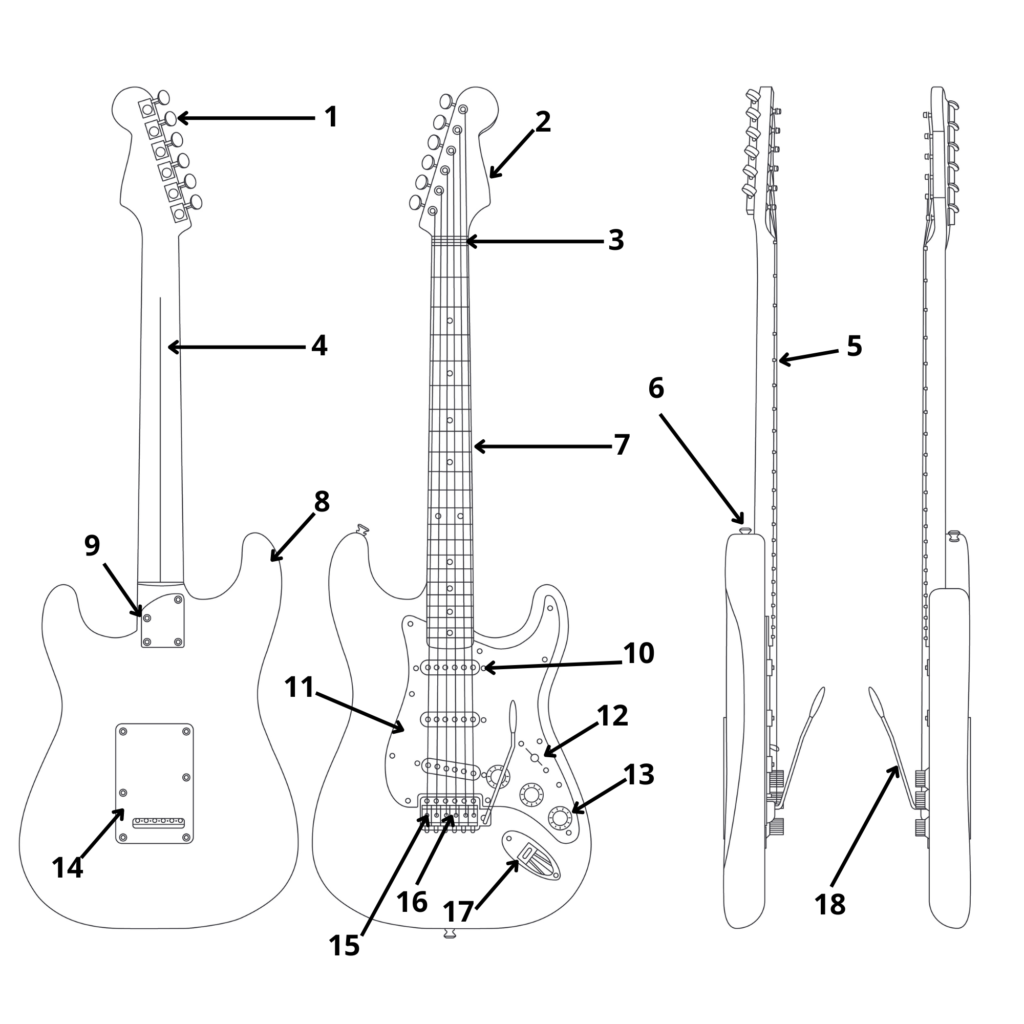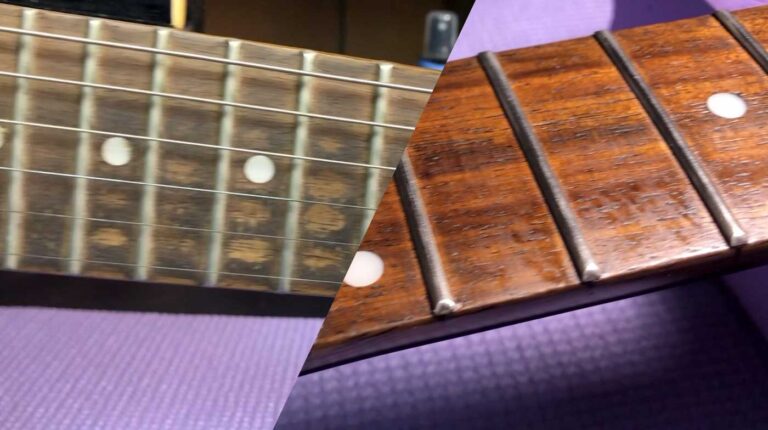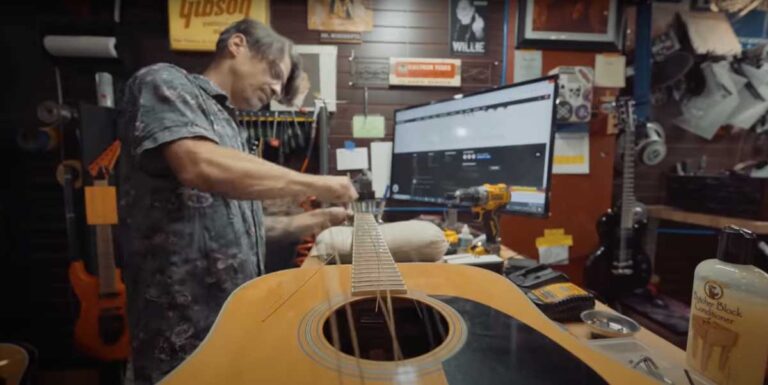Welcome to our comprehensive guide on guitar anatomy! Whether you’re a seasoned player or a beginner eager to get acquainted with your new instrument, this article will delve into the intricate details of every component that makes a guitar tick. From the headstock down to the body, we’ll dissect each part, explaining its function and exploring how it contributes to the overall sound and playability of the guitar. So, let’s embark on this musical journey and gain a deeper appreciation for the craftsmanship behind these stringed masterpieces.

ELECTRIC GUITAR
1. Tuning Pegs
Tuning pegs, also known as machine heads, are crucial mechanisms located on the guitar’s headstock. They allow players to adjust the tension of each string, controlling its pitch. Here’s what you need to know:
- Materials: Tuning pegs can be made from various materials, influencing the guitar’s tone.
- Ratio: Higher gear ratio provides finer tuning control.
- Locking vs. Standard: Locking tuners enhance tuning stability.
- Variants: Open vs. Closed, Vintage-style vs. Modern.
Tips: Regularly inspect tuners, upgrade for better stability, and wind strings correctly for optimal performance.
2. Headstock
The headstock, located at the top of the guitar neck, is more than a visual feature. It plays a crucial role in string tension and tuning stability. Key aspects include:
- Function: Affects string tension, tuning stability, tone, and playability.
- Variants: 3+3 vs. 6 in-line, Slotted vs. Solid.
Tips: Maintain the headstock, consider balance in customization, and be cautious to prevent damage.
3. Nut
The nut, a small rectangular piece at the headstock end, is often overlooked but vital for playability. Here’s what you should know:
- Material Matters: Different materials influence tone and sustain.
- Setting the Action: Nut height affects string action.
- Intonation Importance: Nut influences intonation, especially in the first few frets.
Tips: Smooth nut slots, lubrication for tuning stability, and adjustments for different string gauges.
4. Neck
The neck is the long, flat piece extending from the body, where you press down on the strings to create notes. Understanding neck profiles, construction, and the truss rod is essential. Key points include:
- Neck Profiles: Shapes like “C,” “U,” “V,” and “D” cater to individual preferences.
- Neck Construction: Bolt-on, set neck, and neck-through constructions.
- Truss Rod: Adjusts neck curvature for consistent action.
Tips: Check for fret buzz, consider finish for playability, and choose based on personal comfort.
5. Frets
Frets are thin metal strips along the fretboard that change the pitch of the strings when pressed. Knowing about fret size, wear, and maintenance is crucial. Here’s what you need to understand:
- Fret Size: Jumbo vs. Vintage, influencing playability.
- Fret Wear: Regular maintenance to avoid buzzing and intonation issues.
- Refretting: When and how to replace worn frets.
Tips: Keep strings clean, inspect frets for wear, and understand the impact of fret size on playability.
6. Strap Buttons
Strap buttons might seem minor, but they serve an essential function, especially for performers. Here’s what you should know:
- Security: Regularly check and tighten screws.
- Strap Locks: For added security during performance.
- Materials & Styles: Various materials and designs for customization.
Tips: Ensure secure attachment, be cautious with screw sizes, and understand their importance for stage performance.
7. Fretboard
The fretboard, or fingerboard, is the front face of the neck. It’s more than a functional component; it significantly influences playability, tone, and aesthetics. Key aspects include:
- Materials: Rosewood, maple, and ebony contribute unique characteristics.
- Radius: Curvature affecting comfort and playstyle.
- Inlays: Decorative elements aiding fret navigation.
Tips: Understand layout for beginners, regular maintenance, and appreciation for its role in playability.
8. Body
The body is the heart of the guitar, influencing aesthetics, playability, and tone. Different woods, body styles, and finishes contribute to the instrument’s character. Here’s what you should know:
- Materials: Wood choices affecting tonal qualities.
- Solid, Semi-Hollow, and Hollow Bodies: Influencing tone in electric guitars.
- Acoustic Body Styles: Shapes impacting sound projection.
Tips: Consider body shape for comfort, regular cleaning, and understanding its role in defining the instrument’s character.
9. Neck Mounting Plate
Often overlooked, the neck mounting plate is crucial for the structural integrity of a guitar. Here’s what you need to understand:
- Neck Joint Types: Bolt-on, set-in, and neck-through constructions.
- Materials: Generally made of sturdy metals for stability.
- Variants: Four-screw mounting plate, Micro-Tilt Adjustment.
Tips: Regularly check screws for tightness, consult professionals for adjustments, and be cautious with modifications.
10. Pickups
Pickups are the voice of an electric guitar, converting string vibrations into electrical signals. Different types, including single-coil, humbucker, and active pickups, offer unique tones. Here’s what you need to know:
- Single-Coil vs. Humbuckers vs. Active Pickups: Different sounds for different styles.
- Variants: P90s, Noiseless Pickups, Wide Range Humbuckers.
Tips: Adjust pickup height for tone, choose based on musical genre, and consider noise reduction options.
11. Pickguard
The pickguard, often overlooked, serves both a protective and aesthetic function. Key points include:
- Materials: Plastic, metal, wood, or custom designs.
- Shapes and Sizes: Fitted to specific guitar models.
Tips: Beyond protection, pickguards can add a unique visual element to your guitar.
Meta description:
Dive into the intricate world of guitar anatomy! Explore the functions and significance of each component, from tuning pegs to pickups, and gain a profound understanding of how these elements shape the sound and playability of your instrument.




